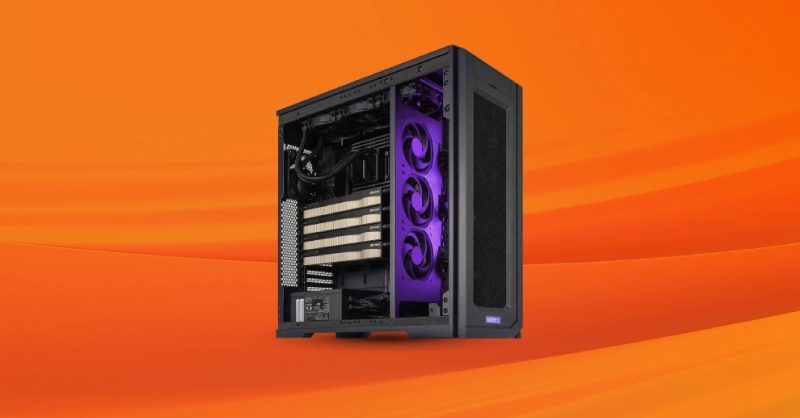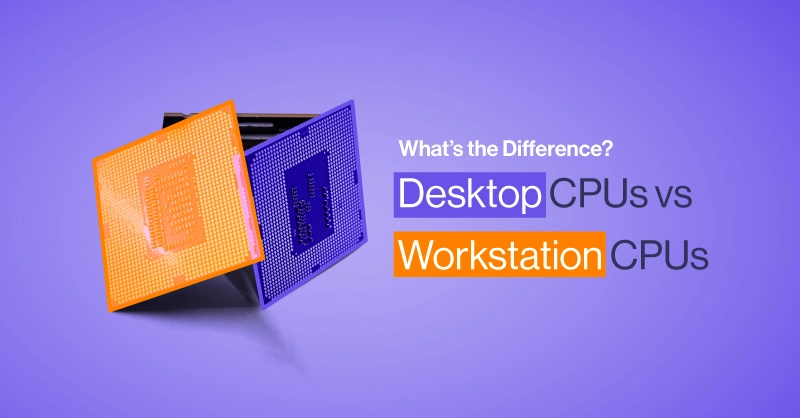Introduction
When working with demanding workloads like AI development, 3D rendering, or engineering simulation any processor and computer can get the job done…eventually. Desktop CPUs are most common, used in PCs and gaming rigs and some professional workloads. Workstation CPUs take it to the next level, mainly used to power professional workloads that need that extra oomph. Selecting the appropriate processor is matter of use case and performance expectation.
Let’s breaks down the key differences between desktop and workstation CPUs and help you understand where each excels. We want to answer the question, when to a choose a desktop CPU or a workstation CPU for certain professional tasks.
What Is a Desktop CPU?
Desktop CPUs are processors designed for consumer or light professional workloads. It offers strong performance, high clock speeds, and an attractive price-to-performance ratio. These CPUs are ideal for activities like:
- Gaming
- Light Productivity
- Basic content creation (photo/video editing)
Desktop CPUs prioritize responsiveness and peak performance in short bursts, which suits most day-to-day tasks. They’re also typically part of platforms with just enough expandability for the normal user featuring fewer PCIe lanes, lower RAM capacity, and basic I/O. Popular examples include the Intel Core Ultra (previous Core iX) and AMD Ryzen 7000/9000 CPUs.
A desktop CPU is not by any means a poor or bad processor. They are the right choice for most use cases and can accomplish complex tasks in a pinch. If you need to render some 3D graphics, design low-poly CAD models, or needed to run a local LLM, these processors will the job done.
What Is a Workstation CPU?
Workstation CPUs are purpose-built processors for professionals who rely on their machines for continuous, heavy-duty workloads. These processors are optimized for stability, scalability, and high performance. A workstation CPU can game, but are mainly used for:
- AI training and inference prototyping
- Engineering simulation (FEA, CFD)
- Molecular dynamics simulation and imaging
- Scientific computing and data analysis
- High-end VFX and content creation
Workstation processors have a wider range of use cases with a SKU stack that balance core counts and clock speeds, each ideal for different HPC workloads. Workstation CPUs often feature:
- ECC memory
- Larger L3 caches
- 4 or 8-channel memory
- A lot more PCIe lanes
Examples include Intel Xeon W and AMD Ryzen Threadripper Pro CPUs. Workstation platforms also tend to offer validated support for long uptimes and compatibility with pro-grade components like multi-GPU setups and high-speed networking.

Key Differences Between Desktop and Workstation CPUs
A workstation can be defined as a powerful PC that any professional uses to execute their workload. But the true differentiation between desktop processor and workstation processor is less vague. Core count, PCIe lane count, memory support, and I/O. differentiate a workstation processor over consumer desktop processors
Core Count and Architecture
While desktop CPUs can offer higher core counts than some workstation CPUs, core counts don't tell the full story. Workstation CPUs often deliver better performance per core under sustained workloads with larger caches, better thermals, and performance for parallel tasks.
A 16-core AMD Ryzen 9950X is a very capable CPU that can handle a lot of HPC workloads like graphic design, video editing, and content creation. But, a 12-core AMD Threadripper PRO 7945WX can outperform a 16-core Ryzen 9950X in real-world scenarios due to the additional memory channels, and more PCIe lanes for storage and GPUs.
PCIe Lanes
Speaking of PCIe lanes, this is one of the biggest differentiators. Desktop CPUs typically provide 16–24 PCIe lanes, which limits your ability to add multiple GPUs, NVMe SSDs, and other expansion cards. In contrast, workstation CPUs can support 80+ PCIe lanes, giving you far more flexibility for:
- Multi-GPUs on full PCIe x16 lanes compute workloads
- Multiple NVMe drives on RAID storage arrays
- High-speed networking cards or specialized accelerators
Memory Support
Workstation CPUs support higher memory capacities and bandwidth, often via 4-channel (AMD Threadripper 7000X/9000X and Intel Xeon W-2400/2500) and 8-channel (AMD Threadripper PRO 7000WX/9000WX and Intel Xeon W-3400/3500) More importantly, they support ECC (Error-Correcting Code) memory, which prevents data corruption and is essential in scientific or financial workloads where integrity matters.
I/O and Connectivity
Workstation platforms typically feature more advanced I/O capabilities built into the motherboard and in the chipset. This allows for better integration into complex setups that can be tailored for any workload.
- More USB and Thunderbolt ports
- 10Gb Ethernet
- Greater number of SATA or NVMe connections
When a Desktop CPU Is Enough—and When It Absolutely Isn’t
Not every workload demands the muscle of a workstation CPU. In fact, for many users, a high-end desktop processor offers more than enough power. If your workflow involves dense spreadsheets, low complexity graphic design, editing short 4K clips, and occasionally rendering in Blender, you might find the cost and complexity of a workstation CPU unnecessary. Desktop platforms, and the supporting hardware, are more affordable, especially if peak performance and speed aren’t a necessity.
But the equation changes dramatically once you step into the realm of sustained, compute-heavy tasks.
Workstation-class processors shine in environments that require scalability, reliability, and high throughput over long durations. They provide the PCIe lanes and bandwidth needed to run multiple GPUs, NVMe drives, and/or high-speed networking cards simultaneously. And perhaps most critically, they’re designed to operate under sustained load without throttling, stuttering, or failing.
- Multi-threaded Workloads - Tasks that can utilize many CPU cores simultaneously. Desktop processors’ top end only go up to 24, whereas workstation processors like AMD Threadripper PRO go up to 96 cores.
- I/O Bound Workloads - Operations requiring extensive data transfer between storage, memory, and processing units. Desktop processors don’t have enough PCIe lanes to support many devices.
- Memory Intensive - Applications that need large amounts of RAM and high bandwidth. Where desktop processors only support dual-channel, workstation processors have 4 and 8 channel memory support.
- Speed is a Priority - When time equals money and faster processing directly impacts productivity
- Application can Scale with Multi-GPU - Software that benefits from multiple graphics processors working in parallel. Desktop processors don’t have enough PCIe lanes to support multiple GPUs running on full bandwidth.
- Workload is Continuous or Extensive - Tasks running for hours or days that require stability and reliability. Workstations typically have a lot of downclocked cores to be able to run at 100% usage over long periods of time.
FAQ - Frequently Asked Questions about Workstation CPUs
What’s the difference between a desktop CPU and a workstation CPU?
Desktop CPUs are built for general-purpose use with high clock speeds and good single-threaded performance. Workstation CPUs are designed for professional workloads and offer more memory support, PCIe lanes, and better sustained performance under heavy load.
Why are workstation CPUs more expensive than desktop CPUs?
Workstation CPUs include support for ECC memory, more PCIe lanes, and greater I/O capabilities. They’re also validated for longer runtimes and higher reliability, resulting in a higher cost that is worth it for mission critical workloads.
Can a desktop CPU handle professional workloads like CAD or simulation?
For light to moderate design and simulation, yes. Some simulations workloads can be ran entirely on the GPU, though you will need a GPU with ample VRAM. But if your projects involve large datasets, complex simulations, constant rendering, or is CPU-reliant, a workstation CPU is more reliable and better suited.
Is a higher core count always better for performance?
Not always. A workstation CPU with fewer but higher clock speed cores and higher memory bandwidth can outperform a higher-core-count desktop CPU in some cases. You can experience this in memory-heavy or I/O-bound workflows. Read more about core-count vs clock speed here.
What are some desktop CPUs and what are some workstation CPUs?
Desktop CPUs include the AMD Ryzen and Intel Core Ultra series. Workstation CPUs include the AMD Threadripper PRO series and Intel Xeon W-Series. Both have an expansive SKU stack for tackling different workloads. Talk to us today to figure out what processor to pick when you configure your SabrePC workstation!
Conclusion & TLDR
The line between desktop and workstation CPUs isn’t just about performance—it’s about purpose. Desktop CPUs are excellent for general computing, creative workflows, and even moderately demanding tasks. But when your project timelines shrink, compute demands intensify, and time to result becomes a priority, a workstation CPU offers a foundation that makes your computing workloads feasible and possible. Workstation processors offer more PCIe lanes for GPU and storage expansion, superior memory bandwidth and ECC support, and I/O built for complex integration.
SabrePC can deliver you an ideal high performance computing solution with options from AMD Threadripper and Intel Xeon W.



